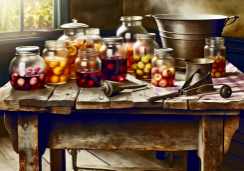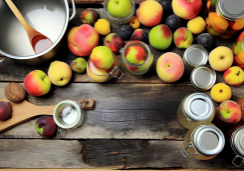12 Essential Tips for Home-Smoked Meats
As the saying goes, 'Too many cooks spoil the broth,' but when it comes to smoking meats at home, it's your personal touch that makes all the difference. You've likely invested in a quality smoker and you're eager to get that perfect blend of smoke and tenderness in your meats. Knowing where to start with cuts, woods, and temperatures can be daunting.
But don't worry, you're about to uncover the secrets to elevating your smoked meats from just good to outstanding. While brisket may be the Mount Everest of smoked meats, with these 12 essential tips, you'll conquer the challenges and avoid common pitfalls.
So, grab your tongs and thermometer; it's time to transform that chunk of meat into a mouthwatering masterpiece. And remember, the devil is in the details, and we're about to reveal some game-changing nuances that could set your smoked meats apart.
Choose the Right Smoker
Selecting the ideal smoker is crucial, as it's the heart of the home-smoking process, directly influencing flavor, ease of use, and the overall success of your meat-smoking endeavors.
You need to select the right type, whether it's electric, pellet, offset, or charcoal. Charcoal smokers and offset rigs, embraced by purists, offer a hotter, more flavorful burn. They require mastery over fire management, but the payoff is extraordinary—succulent meats infused with that quintessential smoky taste.
For precision and convenience, pellet grills are the way to go. These marvels use wood pellets and an automated temperature guide to maintain the perfect smoking environment. You'll enjoy consistent results with less fuss.
Gas grills can also be contenders, especially when outfitted with wood chunks to enrich the flavor profile.
Select Quality Meats
To elevate your smoking game to the next level, always opt for high-quality meats with good marbling and adequate fat content. Selecting quality meats isn't just a step—it's the foundation that dictates the depth of flavor and tenderness in your final dish. Whether you're reaching for a pork shoulder or a beef brisket, remember that the best meat often comes from animals that have been well cared for and fed.
When you're at the butcher's counter, keep these key points in mind:
- Seek out Wagyu beef for an unbeatable melt-in-your-mouth experience due to its exceptional marbling.
- Choose a pork shoulder with a generous fat cap; it'll baste the meat during the long smoking process, ensuring succulence.
- Don't shy away from different types of meats; each offers unique flavors and textures.
- Inspect cuts of meat closely; look for even distribution of fat and a rich, vibrant color.
As an experienced smoker, you know that the secret to unforgettable, mouthwatering barbecue lies in the quality of the ingredients. By selecting the finest cuts, you're not just cooking; you're crafting a masterpiece. Remember, your passion for the craft is as important as the meat you select.
Understand Meat Cuts
You've picked top-quality meats, now let's talk cuts.
The thickness and marbling of your chosen cut will dictate your smoke approach and time—fattier cuts like pork shoulder embrace the smoke, staying juicy, while leaner cuts like brisket demand your attention to avoid toughness.
Master the nuances of meat cuts, and you'll unlock a world of flavor and texture in your smoking endeavors.
Selecting Quality Meat Cuts
Embarking on the journey of home-smoked meats begins with mastering the art of choosing the right cuts, with marbling and fat content acting as key indicators of succulent results. When selecting quality meat cuts, you're not just buying a piece of meat; you're setting the stage for a masterpiece of flavors and textures.
Here's what to look for:
- Marbling: Opt for cuts like brisket with good marbling; it melts during smoking, adding flavor.
- Fat Content: Cuts with higher fat, such as pork butt, ensure moist and tender meats for smoking.
- Type of Meat: Start with more forgiving types like poultry or sausages before tackling beef or pork.
- Size Matters: Depending on the cut, larger pieces often smoke better, offering a more consistent result.
Choose wisely, and your smoked meats will talk of the town!
Meat Thickness and Smoking
Understanding the relationship between meat thickness and smoking is crucial, as it directly influences the cooking time and the overall flavor infusion of your smoked delicacies. Thicker cuts demand patience and mastery of lower temperatures to cook your meat thoroughly, ensuring that internal temperature rises evenly, and the smoking process works its magic.
You've got to give those succulent pork shoulders and ribs the indirect heat they deserve, letting fat render slowly, melding with smoke to create a masterpiece. On the flip side, thinner cuts like fish or skirt steak are your high-stakes game, requiring a vigilant eye to avoid overcooking.
Each meat cut, with its unique thickness and fat content, is a new challenge. Embrace it, and you'll unlock an array of flavors that are utterly rewarding.
Use Seasoned Woods
Selecting the right seasoned woods, such as hickory, apple, or pecan, can elevate your home-smoked meats with rich, aromatic flavors. The wood you choose isn't just a fuel source, it's an ingredient adding a distinct layer of flavor to your culinary masterpiece.
Here's what you need to know:
- Experiment with different woods to discover which type of wood imparts the best flavor for your specific cut of meat. Each wood has its own unique smoke flavor profile that can complement beef, pork, poultry, or fish.
- Keep a variety of Wood Chips for Smoking on hand. These chips are vital for shorter smokes, infusing quick yet intense layers of smoke flavor.
- Stock up on wood chunks when adding wood to conventional smokers. These denser pieces provide a longer-lasting smoke, perfect for those extended cooking sessions.
- Don't be afraid to mix woods. Combining woods like oak with cherry can create a complex, harmonious taste experience that enhances the natural flavors of the meat.
Control Smoking Temperature
Now that you've chosen your seasoned woods to infuse flavor, it's crucial to master the art of controlling the smoking temperature to ensure your meats are perfectly smoked every time. Arm yourself with a reliable meat thermometer; it's your best ally in the quest to maintain a steady heat range between 200 and 250°F. Remember, precision is key during your smoking session.
Proper ventilation can make or break your ability to control smoking temperature. Adjust those vents! They're not just there for show. They regulate airflow, which in turn, manages the heat and smoke caressing your meat. A perfect fire is all about balance, and adjusting vents is how you choreograph this dance.
Keep the lid down! I can't stress this enough. Every peek sends precious heat and smoke spiraling into the ether, causing drastic temperature fluctuations that can derail the cooking process. Trust in your setup and let the smoker work its magic.
Don't overlook the humble water pan. It's not just there to add moisture; it's a buffer that absorbs heat, contributing to a more stable environment inside your smoker. Control smoking temperature like a pro, and you'll be rewarded with the kind of succulent, smoky meats that legends are made of.
Master Meat Preparation
Begin your journey to flavor mastery by choosing meats that are best suited for the low-and-slow art of smoking. Your dedication to the craft will shine through when you pick the right cuts—ones that transform under the watchful eye of smoke and heat. Whether it's the rich marbling of a brisket or the succulent potential of pork shoulder, the right selection makes all the difference.
To prepare your meat for the smoker, consider these steps:
- Dry Rub: Generously season your meat with a dry rub that complements its flavors. Let it rest until it reaches room temperature, allowing the spices to penetrate deeply.
- Olive Oil: Lightly coat the meat with olive oil; this not only helps the rub to stick but also aids in creating a perfect crust.
- Brine: For meats like smoked pork, a brine can work wonders, keeping your meat moist and tender during the long smoking process.
- Butcher Paper: Wrapping your meat in butcher paper during the latter stages of smoking can protect the bark you've worked so hard to create, while still allowing it to breathe and continue taking on smoky goodness.
Manage Smoke Flow
To achieve the quintessential smoky flavor without overpowering your meats, you'll need to master the art of managing smoke flow within your smoker. This means you've got to adjust those vents with precision, ensuring that the airflow is just right to maintain optimal smoke circulation. It's not just about letting the smoke dance around; it's about controlling it to add layers of flavor that will tantalize the taste buds without letting it overpower the taste of your meat.
Keep an eye on how the smoke behaves. If it's billowing out like a freight train, chances are your meats are taking on more than they should. Gentle, consistent smoke flow is your ticket to enhancing both the flavor and the tenderness of your meats. This is especially true when you're working with a charcoal grill, where the balance of smoke and air can make or break your barbecue masterpiece.
Always aim for clean, white smoke—this is the gold standard for the best smoking results. If the smoke turns acrid or black, adjust your vents, and check your charcoal. Remember, it's not just about cooking; it's about crafting an experience with each smoky bite.
Maintain Proper Humidity
While expertly managing smoke flow is essential for flavor, don't overlook the importance of maintaining proper humidity to ensure your meats remain succulent throughout the smoking process. Mastering the art of smoking meat means you're also adept at controlling the environment inside your smoker. Humidity is your secret weapon against dryness, and it's all about balance – adding too much moisture can be just as detrimental as not enough.
Here are a few seasoned tips for smoking meat that will help control humidity and keep your meats perfectly moist:
- Use a water pan: It generates steam, which helps maintain moist, smoky heat without saturating your meat.
- Spritz with apple juice: This not only adds a hint of sweetness but also keeps the meat moist. Do this every hour for the best results.
- Wrap in butcher paper: Unlike aluminum foil, butcher paper lets the meat breathe, retaining moisture while still allowing smoke to penetrate.
- Add flavor to your water pan: Infuse spices, beer, or wine for an extra flavor boost that subtly complements the smoke.
Monitor Cooking Times
Mastering the art of home-smoked meats hinges on your vigilance with cooking times; a wireless thermometer is your trusty sidekick, ensuring the internal temperatures are spot-on without constant lid lifting. Remember, perfection takes time, and patience is your virtue here. The key is to maintain a consistent temperature in your cooking chamber, adjusting wood, charcoal, and air vents as needed.
Every couple of hours, take time to check on your meat with that wireless thermometer. Resist the temptation to open the lid too often; you're not just losing heat, but also that precious smoke that imparts the deep, complex flavors you're after. When the meat is done depends on the meat itself—the cut, size, and the smoker's steadiness. A general rule is to allow it to cook slowly and thoroughly.
Mindfully monitor the smoking process, never leaving your fire unattended. Proper air ventilation isn't just about safety; it's about flavor, ensuring you've got that white smoke that's the signature of well-smoked meat. When smoking, it's not just about the clock but also about the conditions within your smoker. Mastery comes from understanding and responding to these nuances, ensuring your smoked meats are nothing short of sublime.
Rest Meat After Smoking
You've mastered the smoke, but don't rush the final stretch; resting your meat is pivotal for that succulent payoff.
Stick to the golden rule: give it 10-20 minutes under a foil tent to let those juices settle and the flavors peak.
Trust me, this pause doesn't just perfect your meat's texture—it's the secret to a meal that'll be savored to the last bite.
Importance of Resting
Resting your smoked meats is a critical step, ensuring that every slice is imbued with maximum juiciness and robust flavor. When you've invested hours in slow cooking your delicious smoked creation, don't let impatience lead you to slice too early. Remember:
- Resting: Allows flavors from your dry rubs and smoky goodness to fully permeate the meat.
- Moisture: Prevents the juices from escaping, keeping each bite succulent for your taste buds.
- Food Safety: Ensures that the heat distributes evenly, which can be crucial for food safety.
- Patience Pays Off: Trust that resting is the difference between good and great smoked meats.
Let the meat on the opposite side of your patience – it's worth the wait.
Resting Time Guidelines
Having established the importance of patience in resting your smoked meats, let's explore how long to let different cuts sit before carving into that succulent feast.
For pork, the resting time guidelines are crucial to achieve that perfect tenderness and smoky flavor. After you take your meat directly from the smoker, resist the temptation to slice it immediately. Instead, place your meat on one side, away from direct heat, and let the fibers relax.
Smaller cuts like chicken need about 10 to 15 minutes under a foil tent.
But for the king of smoked meats, pulled pork, patience is key. Envelop it loosely in foil and let it bask in its own warmth for at least 30 minutes to an hour. This pause is what makes all the difference between good and great home-smoked meats.
Experiment With Flavor Profiles
Unlock the full potential of your home-smoked meats by experimenting with diverse wood types, each imparting its own unique flavor profile to your culinary creations. Don't be afraid to mix and match, combining the smokiness of hickory with the subtle sweetness of applewood, or the robustness of mesquite with the delicate touch of cherry. Your grill isn't just a cooking device, it's your canvas, and wood is your palette.
Here's how you can become a maestro of meat:
- Experiment with flavor profiles: Blend spices and herbs to craft the perfect rub. Think beyond just salt and pepper—embrace a wide variety of seasonings.
- Play with new recipes: Combine your favorite barbecue sauce with a dash of cider vinegar for a tangy twist.
- Match your meat: Pair different woods with specific meats—applewood for pork, hickory for beef, and so on. Each combination is your secret weapon in the flavor arsenal.
- Layer flavors: Use marinades and glazes to build complexity, ensuring every bite is a symphony of taste.
Clean and Maintain Equipment
You know that the secret to impeccable smoked meats isn't just in the recipe—it's in the upkeep of your smoker.
Establish a regular cleaning schedule to keep your smoker performing at its peak, and don't skimp on proper storage to shield it from the harshness of the elements.
These steps are non-negotiable for the serious pitmaster who demands the best from their equipment, every single time.
Regular Cleaning Schedule
To ensure your smoker operates at its best, adopt a habit of cleaning it thoroughly after each use. You've invested time and passion into cooking those meats to perfection, so don't let maintenance slide. As a Grill Master, you know that the best results come from a grill that's well-kept. Here are some essential steps to make sure your smoker is always ready for the next feast:
- Wipe Down Surfaces: Use warm, soapy water to clean both the interior and exterior surfaces.
- Clean Grates and Pans: Regularly remove and scrub the grates, racks, and drip pans.
- Inspect Vents and Chimney: Keep the airflow optimal by checking and cleaning the vents and chimney.
- Maintain Seals: Check your thermometer, seals, and gaskets to ensure accurate readings and a tight smoke seal.
Proper Storage Practices
Having established the importance of keeping your smoker immaculate, let's focus on how best to store and maintain your equipment to ensure it remains in top-notch condition.
Proper storage practices are one of the easiest ways to protect your investment and keep producing delicious food. After each use, clean your smoker thoroughly; this is fundamental to the basics of smoking.
Shelter your pride and joy in a dry area, safeguarding it from the harsh elements. Regular inspections are crucial—replace any worn parts to ensure your smoker operates safely and efficiently.
Cover it with a protective shield designed for your model to prevent dust and moisture damage.
Adhering to these guidelines is everything you need to become a true aficionado, whether you're a novice smoker or grilling for the first time.
Frequently Asked Questions
What Is the Secret to Smoking Meat?
The secret to smoking meat lies in meticulous meat selection, precise wood choices, and strict temperature control. You'll master smoke density, marinating techniques, cooking times, and meat resting to achieve that perfect smoke flavor.
What Do You Soak Meat in Before Smoking?
You'll soak your meat in brine solutions or acidic marinades, applying dry rubs or injection techniques for deep flavor infusions. Remember, marinating basics and soaking duration vary with meat selection.
How Do I Get Better at Smoking Meat?
To get better at smoking meat, focus on meat selection, master temperature control, and choose woods carefully. Ensure proper smoke flow, apply dry rubs, invest in quality equipment, and always include a resting period.
What Keeps Meat Moist When Smoking?
To keep meat moist while smoking, ensure fat retention, use a water pan, and maintain low temperatures with indirect heat. Select meats wisely, wrap in foil, and baste frequently for optimal moisture control.
Conclusion
You've mastered the art of smoke and savor, transforming humble cuts into succulent feasts. Remember, your smoker's not just a tool, it's your partner in culinary craftsmanship.
Choose quality meats, tend them with precision, and let seasoned woods impart their whispers of flavor. Keep your equipment pristine, and the results will honor your efforts.
Now, go forth and smoke with confidence, knowing each bite tells the story of your passion and dedication to the craft.










